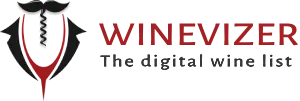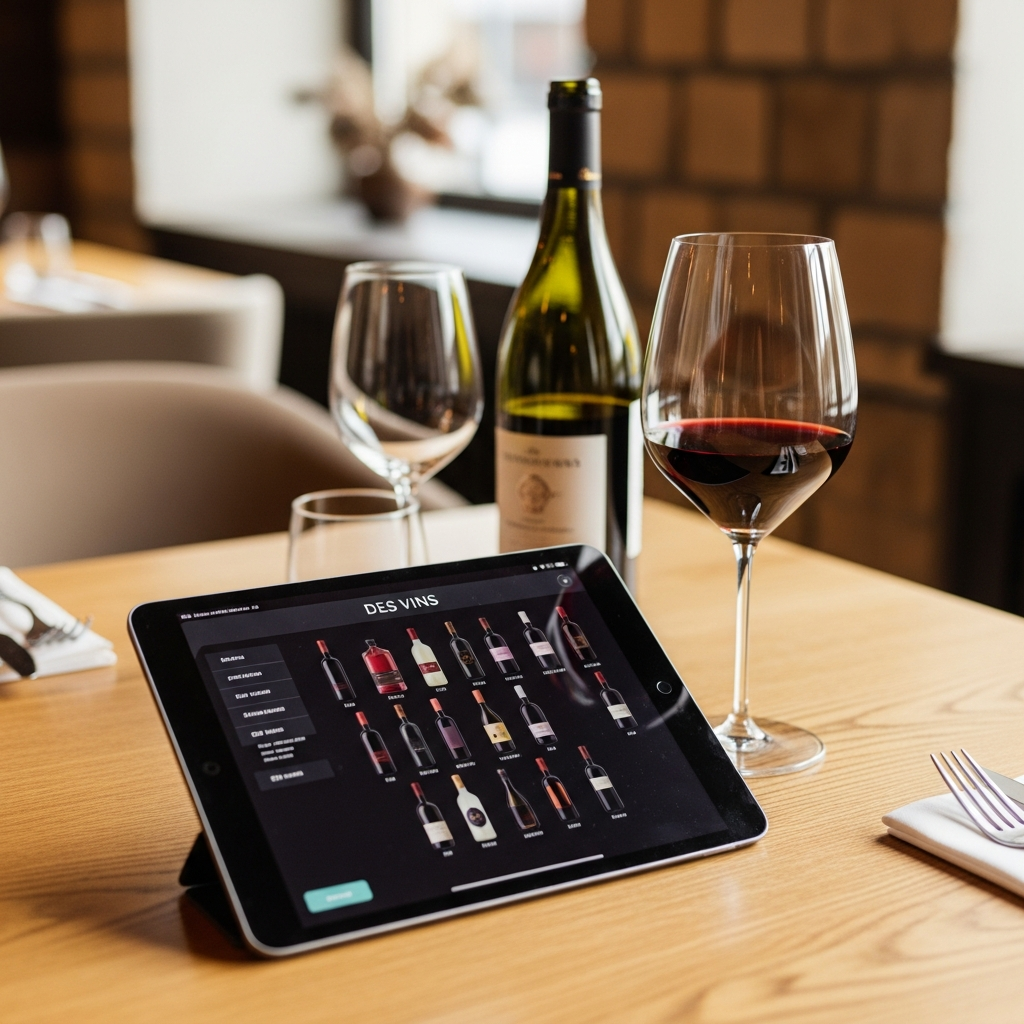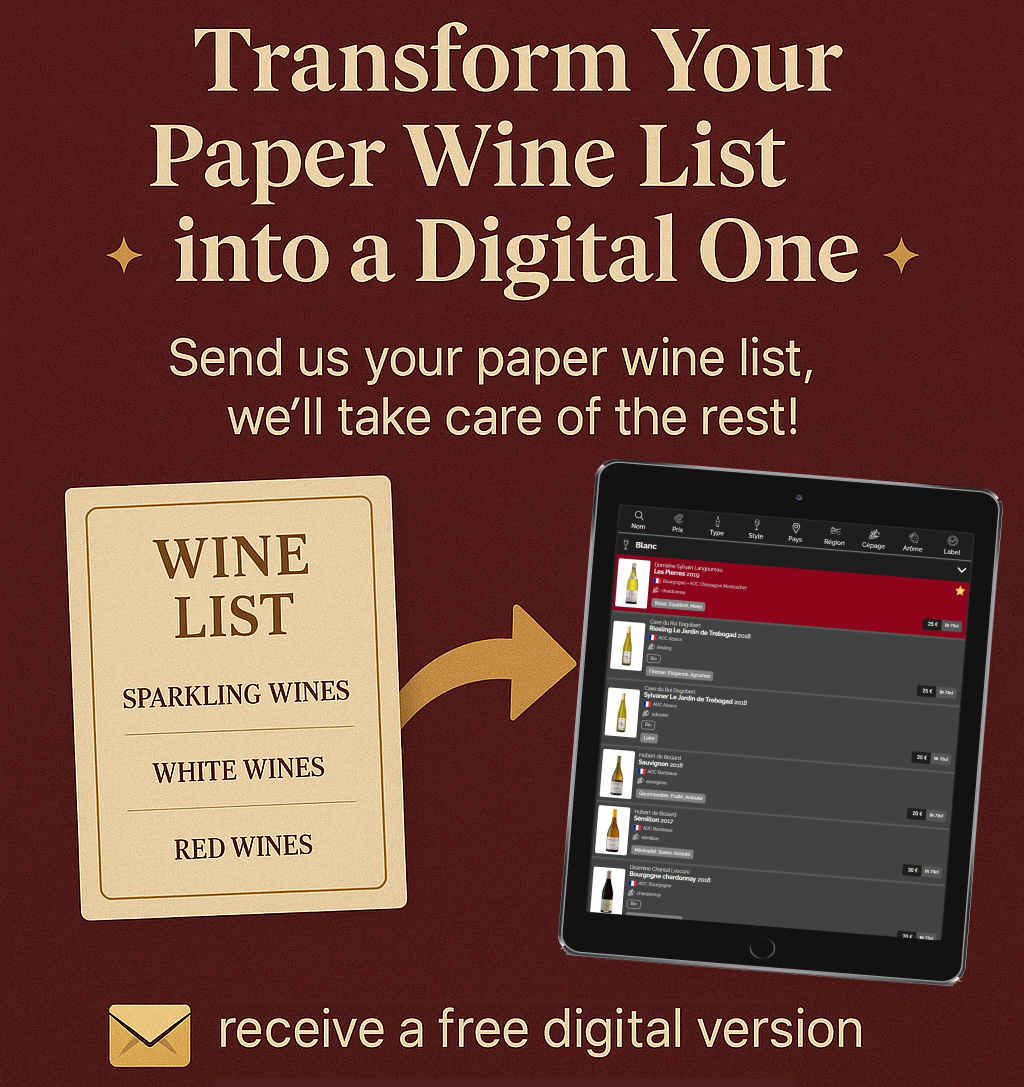Are you looking to create your restaurant menu for free or to make your restaurant menu without sacrificing aesthetics or commercial effectiveness? Good news: it’s possible, provided you proceed methodically. Whether you manage a restaurant, a wine bar, or a hotel, this guide shows you how to produce a clear, sellable menu that can be used both in-house and online, without software budget. And if your menu includes a selection of wines, we will see how to digitize it in a few minutes and how the Winevizer system can save you time while enhancing the customer experience.
What "creating your restaurant menu for free" means today
There are several ways to create a free and professional menu:
- An elegant PDF menu, designed with free tools (Canva, Google Docs, Figma/Adobe Express in free version), printed or shared online.
- A simple web page hosted on your site (or a page shared from a document) that you link via a QR code.
- A digital wine list accessible via QR, tablet, or smartphone, updated in real-time without reprinting.
The goal is not just to save money: your menu must sell, be readable on mobile, comply with regulations (allergens, prices including tax, etc.), and reflect your identity. Follow the steps below to go from idea to a ready-to-serve menu.
How to create your restaurant menu for free, step by step
1) Clarify the objective of your menu
- Target audience: express lunch, gourmet dinner, hotel clientele, wine bar, room service, terrace…
- Context of use: laminated paper, chalkboard, scanned PDF in QR, "Tablet Wine List" for the staff.
- Tone & image: warm, contemporary, minimalist, local… Your menu is a branding tool as much as a sales tool.
2) Structure the offer into clear sections
The structure influences the average basket size. Simplify, prioritize, and guide the eye.
- Starters, Main Courses, Desserts (or Small Plates, To Share, Signatures, Daily Menu).
- Beverages: non-alcoholic, beers, cocktails, coffees, and of course "Wine List".
- Wine bar: organize by color, origin, style (light/fruit, full/oaky), or consumption moments (aperitif, meal, dessert).
- Hotel: distinguish breakfast, snacking, room service (24/7 or time slots), late check-in.
3) Write enticing titles
- Favor short and memorable names, then a precise and appetizing description.
- Highlight a benefit: cooking method, texture, origin, seasonality, recommended food-wine pairing.
- Translations: if you welcome an international clientele, offer at least English (avoid literal translations).
4) Adjust prices with a menu engineering logic
- Highlight the "star products" (margin + popularity) with a discreet box, an icon, or a strategic position.
- Use a "decoy" choice to enhance a signature dish (a deliberately less competitive option allows you to raise the perceived value of the option to push).
- Group intelligently: lunch formulas, tasting menus, food-wine pairings.
5) Comply with local regulations
Check the requirements of your country or region: display of prices including tax, allergens, origin of certain meats/fish, alcohol mentions, vintages, VAT. The information must be clear and accessible; provide a box "Allergens: inform us" and/or a coded list.
6) Choose a free template and take care of the layout
- Tools: Canva (menu templates), Google Docs (simple layout), Adobe Express/Figma (free versions), Google Sheets (structured lists then export PDF).
- Fonts: one title font + one readable text font; avoid too many styles.
- Strong contrasts (light background/dark text or vice versa) for reading in low light.
- Avoid overloaded menus; aim for breathability and regular spacing.
7) Photos: when and how?
- On paper, limit yourself to the essentials to keep the menu light.
- Digitally, favor optimized images (reduced weight) and consistent in style.
- Avoid overly generic "stock" photos that discredit.
8) Export the PDF correctly
- Export in high-quality PDF for printing; lightweight PDF (ideally <1 MB) for mobile.
- Name your files legibly: menu-restaurant-name-date.pdf
- Prepare a "no bleed" version for the printer if needed.
9) Upload and create a QR code
- Host the PDF on your site or an accessible drive (public link).
- Generate a QR code via a free generator; test it on iOS and Android.
- Shorten the URL to facilitate offline communication.
10) Test, gather feedback, iterate
- Quick user test: give the menu to 5 people; ask "what would you order?" and "what's missing?".
- Measure the impact: average ticket, menu uptake rate, sales of highlighted products.
- Adjust every 15 days at first, then monthly.
Free templates to adapt according to your establishment
"Bistro/Brasserie" Template
- Starters: Market Soup, Perfect Egg with Mushroom Cream, House Terrine.
- Main Courses: Butcher's Cut, Fish of the Day, Seasonal Risotto.
- Classics: House Burger, Caesar Salad, Chef's Pasta.
- Lunch Formula: Starter+Main or Main+Dessert (clear price, quick preparation).
- Desserts: Tart of the Moment, Chocolate Mousse, Fresh Fruits.
- Beverages: Soft Drinks, Draft Beers, Wines by the Glass (3 whites, 3 reds, 1 rosé), Coffees/Teas.
"Wine Bar" Template
- Sharing Plates: Charcuterie, Cheeses, Tapenade, Hummus, Toast.
- Wines by the Glass: by style (light & fruity, mineral & crisp, full & oaky, spicy & structured).
- Bottles: classified by regions/countries; add 2-3 highlighted "favorites".
- Pairings: suggest 3 simple pairings (e.g.: fresh goat cheese + crisp sauvignon; terrine + light red).
- Non-alcoholic: crafted alternatives (kombucha, artisanal juices).
"Hotel/Room Service" Template
- Breakfast: Continental, Healthy, À la carte (eggs, pastries, hot drinks).
- Snacking: Club Sandwich, Salad, Soup, Hot Dish of the Day.
- Late Arrival: Cold Selection, Ready-to-Serve Desserts.
- Beverages: Soft Drinks, Short Selection of Wines by the Glass/Bottle, Beers, Signature Spirits.
- Availability and Timings: specify hours and average preparation time.
Create a digital menu and QR code for free
The digital menu meets current usage: consultation on smartphone, instant updates (out of stock, dish of the day), reduction of printing costs. To keep it simple and free:
- Create your menu in a document or free design tool, then export as a lightweight PDF.
- Host the file (website, public page on Google Drive or equivalent).
- Generate a QR code (for free) pointing to the URL; print it on table tents, the back of cards, or stickers.
- Add a short message: "Scan for the updated menu" and a short URL just in case.
Best practices:
- One QR per language to simplify the experience.
- Clear titles, sufficient font size on mobile, anchor links to sections.
- PDF download option + "Back to top" button.
- Track scans via a URL shortener or UTM parameters to measure usage.
And for the wine list: simplify without impoverishing
The wine list is a special case: fluctuating availability, vintages, pairings, varying levels of expertise on both client and team sides. A well-designed "Digital Wine List" can save time and increase sales without burdening the service.
Winevizer (digital wine list, virtual sommelier) helps establishments to:
- Present wines clearly (styles, regions, grape varieties) with simple filters.
- Offer food-wine pairings based on your current menu.
- Manage availability and updates in real-time (QR code or tablet).
- Provide a consistent multilingual experience, useful for hotels and international clientele.
- Analyze what customers consult to optimize the assortment.
You can integrate Winevizer alongside your free food menu: a QR for the dish menu, another for the "Wine List QR code" linked to the system, or a "Tablet Wine List" available for staff and customers. Discover Winevizer here: winevizer.com.
Common mistakes to avoid
- Adding too many references: overload harms readability and decision speed.
- Visual disparity: too many fonts, colors, or icons — stay consistent.
- Neglecting mobile: a heavy PDF or a non-responsive page decreases engagement.
- Forgetting allergens and mandatory mentions.
- Creating a QR code that links to a private file or a URL that changes without redirection.
Measure, understand, improve
- Offer performance: most/least sold dishes, margins, preparation times.
- Visual impact: are highlighted products actually ordered? If not, simplify or reposition.
- QR usage: scan rates by service, customer feedback, bounce rates.
- Rotation of the wine list: dormant references to be replaced by sought-after styles.
Tip: create two versions of your menu (A/B) by changing the order of dishes or highlighting a formula. Compare results over two weeks.
Quick checklist before publication
- Clear structure, understandable titles in 5 seconds.
- Mandatory mentions and allergens indicated.
- Prices aligned with your margin goals and positioning.
- Light PDF, readable on smartphone; QR tested on iOS/Android.
- Essential translations available if needed.
- For the wine list: simple filters, glasses/bottles, vintage, easy updates (Winevizer helps with these points).
Frequently asked questions
How to create your restaurant menu for free without design skills?
Use a free template on Canva or Google Docs: replace texts/prices, apply a simple palette, export as PDF. Test readability on mobile. For the wine section, a digital wine list via QR allows you to stay updated without redoing the layout.
What sections should an effective menu include?
Short and logical sections: Starters, Main Courses, Desserts, Formulas, Beverages (including wines by the glass and bottles). For a wine bar: styles or regions, favorites, simple pairings. For a hotel: breakfast, snacking, room service, hours.
Is a QR code for the menu paid?
You can generate a QR code for free with online generators. The important thing is to host your menu (PDF or page) on a public URL and test the scan. Consider a short URL and regular updates.
Should I publish my menu on my site or as a PDF?
Both options work. The web page offers responsive reading and better SEO. The PDF is quick to produce and easy to print; it should remain lightweight for mobile. You can offer both and link via a QR code.
How to manage the wine list that changes often?
Opt for a digital wine list with real-time updates, accessible via QR code or tablet. Solutions like Winevizer facilitate presentation, filters, food-wine pairings, and frequent updates.
Go from idea to a selling menu in 48 hours
By combining a free template, a structure designed to sell, and QR code distribution, you can publish a professional menu in two days — then improve it based on customer feedback. For your wine list, a dedicated tool like Winevizer provides a modern experience (digital wine list, virtual sommelier) and tangible time savings in the dining room.
Want to go further with wines?
Discover how Winevizer helps restaurants, wine bars, and hotels modernize their wine lists and guide customers, without unnecessary complexity.






